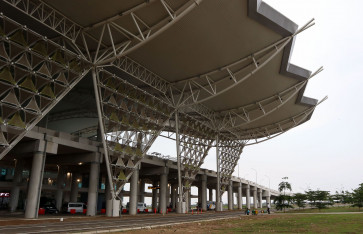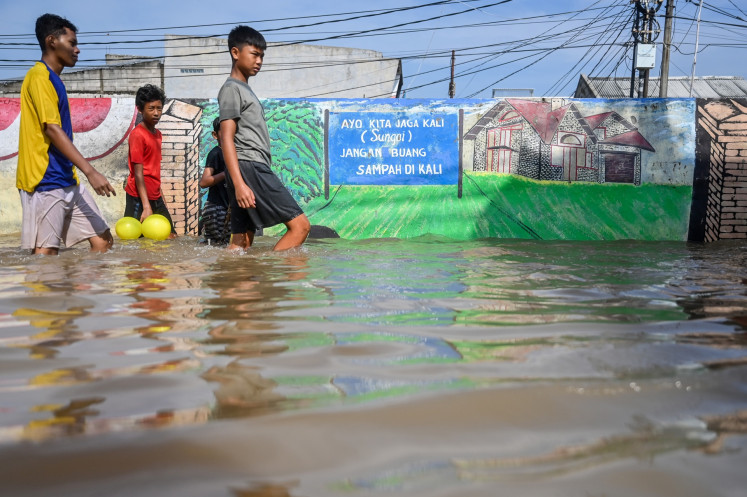Popular Reads
Top Results
Can't find what you're looking for?
View all search resultsPopular Reads
Top Results
Can't find what you're looking for?
View all search resultsFinding Teletubbies village in Yogyakarta
Welcome: The gate to New Ngelepen village is in the shape of an arch
Change text size
Gift Premium Articles
to Anyone
Welcome: The gate to New Ngelepen village is in the shape of an arch.
The first time Sulasmono saw the British children's television series Teletubbies was 14 years ago when toddlers in his village flocked to his living room to watch it at 10 a.m. on weekdays.
He did not like the series, but he knew that Teletubbies comprised four joyous and hilarious multicolored alien toddlers ' Tinky Winky, Dipsy, Laa-Laa and Po ' who lived in a grassy dome-shaped house with two doors at the front and back and four windows.
However, he said, he still could not believe that now, in Yogyakarta, after the show no longer aired, he lived in a home that was similar to a Teletubbies dome house.
The houses of Sulasmono's neighbors also have the same design, driving people to call their village, New Ngelepen, which is around 7 kilometers from Prambanan temple in Sleman regency, Teletubbies village.
'These [dome-shaped houses] were established after an earthquake hit our village,' said Sulasmono, who is the village head.
On May 27, 2006, at 5:50 a.m., a 5.9-magnitude earthquake devastated more than 200,000 homes in the province and Central Java, leaving nearly 6,000 people dead and 1.5 million others homeless.
The earthquake flattened a number of villages, including Ngelepen, which was home to 36 families at that time.
Residents were relocated for six months to temporary shelters around 700 meters from the site, said Sulasmono.
In October 2006, Utah-based non-profit organization Domes for The World Foundation came and constructed the dome-homes using Monolithic EcoShell technology, which means economical, ecofriendly and thin-shelled, with architect Frederick Crandall.
Artistic touch: A mural by well-known mural painter The Popo adorns a dome house.
The foundation teamed up with the World Association of Non-Governmental Organizations and Dubai-based real estate giant Emaar Properties.
'The construction was completed in April 2007,' Sulasmono said, adding that 370 local workers participated in the six-month project, which cost US$1 million, provided by Emaar chairman Mohamed Ali Alabbar.
Besides Indonesia, the foundation has also constructed dome-homes in Ethiopia, India, Haiti and Belize.
Sulasmono did not know the reason why the foundation chose Ngelepen instead of other villages. He thought that his village was selected because compared to the others, it suffered the worst damage and it was also often exposed by local and foreign media.
On 2.3 hectares of land, the foundation established 80 domes that consisted of 71 houses and nine public facilities, such as a school, mosque, medical clinic and six bathrooms.
The domes managed to attract people from other villages to live in Ngelepen.
Each dome, which has two floors, four windows and two doors, is equipped with ample ventilation, light fixtures and power outlets.
'In the afternoon, we feel cold on the first floor and hot on the second floor. Otherwise, at night, we feel hot on the first and cold on the second,' he said.
Sulasmono said that although the homes had an awkward design, the residents did not object after being told that they could withstand the severe effects of wildfire and natural disasters, such as earthquakes and hurricanes.
Built with 2 or 3 inches of concrete and a modest amount of rebar, a dome shell has strengths and weaknesses compared to an ordinary home, which is made of bricks or wood.
With a 15-centimeter thick wall, the domes have proven to be disaster resistant as they have remained stable and strong although earthquakes have rocked the village more than 10 times since 2007, said Sulasmono. 'Every year, earthquakes hit this place once or twice. It usually comes in May.'
Po-faced: Teletubbies character Po welcomes visitors
When an earthquake comes, furniture and other things jolt and fall less in a dome shell compared to inside an ordinary home, he added.
With a diameter of 7 meters and height of 4.6 meters, the dome-homes were assessed as being too small by Ngelepen's people, who mostly work as farmers, because they did not have extra space to store their harvest, said Sulasmono.
Because they still use firewood for cooking, housewives have to cook outside of the domes. If the wood was burned inside, the domes would be full of smoke, he said.
The uniqueness of dome-shaped homes attracts local and foreign people to visit and makes Ngelepen popular as it is the only complex of dome shells in Southeast Asia.
A rising number of visitors motivated Sulasmono to transform New Ngelepen into a tourist village in the area which is already home to more than 15 tourist villages. He then submitted a proposal to the Yogyakarta Tourism Agency, and it gave approval in 2009.
The provincial agency awarded the village Rp 25 million (US$1,835) for tourism development last year, Sulasmono said, adding that the Office of the Coordinating People's Welfare Minister also gave Rp 75 million in 2013, up from Rp 65 million in 2011, through the National Community Empowerment Program (PNPM).
For an entrance fee of Rp 3,000, he said, visitors could not only observe dome-homes, but also play various traditional games, such as congklak (mancala-based wooden board game), dakon (a board game using cowry shells) and gobak sodor (a game with two teams competing).
'We also take the visitors to TeletubbiesHill. From there, they can see the complex of dome-homes from above and enjoy the sunset,' he said.
The number of visitors was around 12,000 in 2014, up 33 percent from 9,000 in 2011, according to Sulasmono, who is also the chief of the Ngelepen Tourism Awareness Group.
The Indonesian Institute of Science's (LIPI) geotechnology division head Haryadi Permana praised Ngelepen's dome shells, but said Indonesia needed more anti-earthquake houses because the world's largest archipelagic country was vulnerable to natural disasters.
'In 2006, for example, a quake was caused by tectonic movement between the Indo-Australia and Eurasia platforms below Indonesian waters,' he said.
Because of natural factors, earthquakes cannot be easily predicted. Therefore, anti-earthquake houses should be constructed before disasters occurred, he said.
Haryadi knew that the dome shells in Ngelepen were designed by a foreign architect, but he argued that the country actually had a lot of talented scientists and architects who were also capable of making anti-earthquake houses. However, they met with great challenges when looking for funds.
'The cost of making anti-earthquake houses can be four times higher than that of making an ordinary home. That is the problem,' he said.
' Photos by A Kurniawan Ulung












